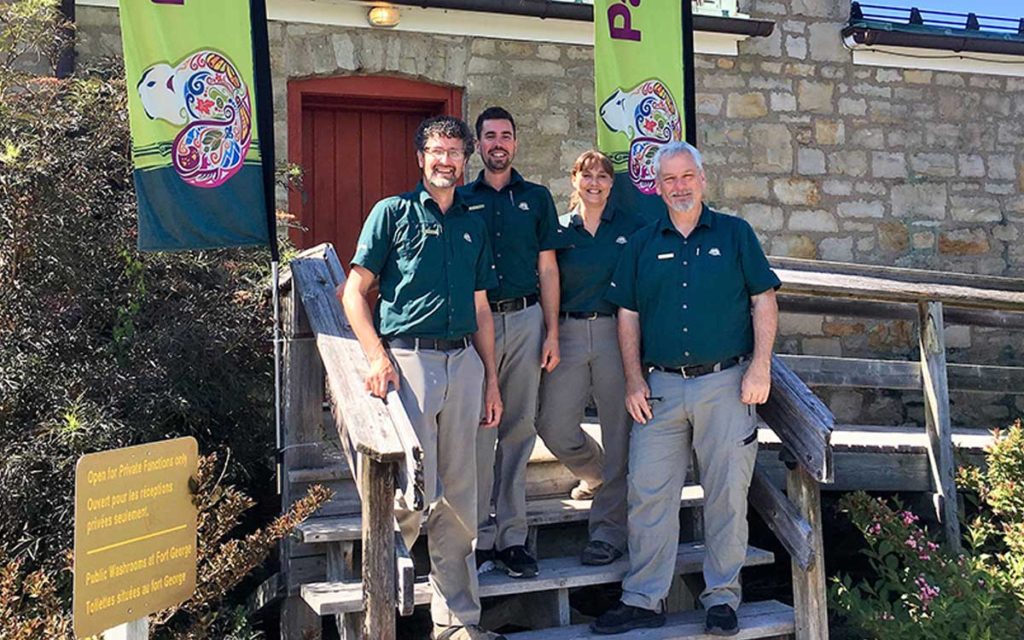
Parks Canada officials stand in front of Navy Hall in Niagara-on-the-Lake on Wednesday, July 18 after giving a presentation regarding new draft management plan and fielding questions from the community.
At the tail end of the 18th century, the first capital of Upper Canada was established in what is today Niagara-on-the-Lake.
For five years, the area drew in top officials from across the colony and served as the provincial seat of government.
However, soon after its installation, Lieutenant Governor John Graves Simcoe decided to move the legislature to York (Toronto). So close to the American border, the initial location was far too vulnerable to attack.
Nonetheless, for decades thereafter, Niagara remained an important economic and military settlement: hosting a number of key engagements throughout the War of 1812.
Naturally, with such a storied past, the northeast corner of the Niagara Peninsula boasts several historic sites and welcomes thousands of tourists each year.
Parks Canada administers seven sites looking over the waters of Lake Ontario and the Niagara River: Fort George, the Battlefield of Fort George, Fort Mississauga, Mississauga Point Lighthouse, Butler’s Barracks, Queenston Heights, and Navy Island.
Recently, the federal agency announced efforts to revitalize the Niagara heritage areas under its commission.
According to the Government of Canada, the 10 year management plan aims to “establish the Niagara National Historic Sites as the premier cultural heritage destination and leading provider of heritage experiences in the Niagara Region”.
By marketing each of the locations under one umbrella, Parks Canada looks to fundamentally create a single tourist destination. All signage will be made uniform and wayfinding will be linked and made more intuitive.
Correspondingly, government agents hope to empower and better include Indigenous voices in the project by consulting local First Nations communities and “telling balanced stories”.
Conservation of the region’s cultural and natural heritage – the physical buildings, artifacts, and landscape – will also be a top priority.
Clad in their emblematic forest green collared shirts, about half a dozen Parks Canada officials fielded questions from community members throughout the day on Wednesday.
Eric Nielsen, manager of external relations for southwestern Ontario, was encouraged by the strong turnout to the Q&A sessions.
“We’ve received a lot of interest and input from local residents”, said Nielsen. “Private citizens, businesses, and stakeholders have all come out to share their opinion”.
The feedback to the proposed management plan has been mostly positive.
Though, the most appealable part of the initiative seeks to repurpose the Battlefield of Fort George and adjacent properties; following the closure of an old sewage facility and military site previously used by the Niagara Region and Department of National Defence, respectively.
The “Lakeshore Properties” that hug the shoreline near Fort George will be handed back to the Crown, once they have been returned to a “park state”.
Efforts will be made to balance public access and the unique, natural surroundings. However, precisely what the vast swath of reclaimed land will be used for is tentative.
“We want to make the right choice, in consultation with the community. The final decision will be considered and defensible”, said Nielsen.
As the plan continues to be evaluated and eventually makes its way through Parliament, it is likely that discernible changes will not be seen for at least four or five years.
The first improved sign from the overhaul is set to pierce soil in 2023.
Community members can still provide feedback online until July 27 by visiting: https://www.pc.gc.ca/en/lhn-nhs/on/fortgeorge/info/plan




















